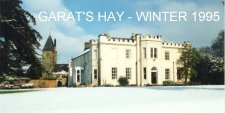
Garats Hay History
According to some sources, the name Hay is linked to the mediaeval process of assarting. This involved bringing former wasteland into a more formal regime of land management. It is probably associated with the old Norse word Haga or Haws, meaning a house or hall. Around the area of Leicestershire concerned, there remain several other examples of Hays and Haws. The Garat's of the name is almost certainly possessive. That is, it denotes the original master of the property or land. Researches reveal little of a Garat. However, early 13th Century records note that a William Gerard held property matching the description of the early site. A corruption of his name, a very common occurrence in those largely illiterate days, may give us a clue to the origins of the house's name.


In the intervening years, Garat's Hay was closely linked to the fortunes of one of Leicestershire's most famous families, the Herricks of Beaumanor. With many other village properties, it was part of the Beaumanor estate when the War Department requisitioned it in 1939. Initially selected to house members of an anti-aircraft searchlight detachment, by 1941 it had become home to girls of the Auxiliary Territorial Service whose main employment was as Special Wireless Operators at Beaumanor.
After the War, faced with crippling death duties and the realisation that he could not afford to run the estate economically, the then owner, Lt Col Assheton Penn Curzon Howe Herrick, decided to dispose of its assets. In a sale conducted at the Town Hall in Loughborough on the 20th and 21st of December 1946, the War Department bought both Beaumanor Hall and Garat's Hay. Although Beaumanor was sold to the County Council many years ago, Garat's Hay remained in military hands until January 1998. At that time, after lying empty for many months when the nearby military training centre closed, it passed into private hands. Throughout 1999 private developers prepared new homes, with some advertised at as much as £0.5M. An advertisement to this effect appeared in the Loughborough Echo of the week ending 12 November, 1999. Since then, at least two large private residences have been built in the spinney beside the old Mess building, the former guardhouse has been turned into a home and let to tenants and a private owner has moved into one of the two homes into which the Mess main building has been divided. The site of the old barracks has been developed and is now the Defence Sixth Form College
Readers who have found this interesting would wish to know about two volumes dedicated to providing a pictorial history of the Woodhouses (Woodhouse Village within which Garats Hay is situated and the neighbouring Woodhouse Eaves). Details can be found by clicking here.
For those who are interested (and who can afford the download time!) there are more recent pictures of Garats Hay Barracks and Woodhouse Village here.
